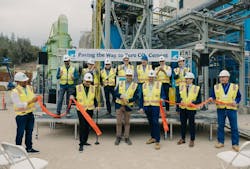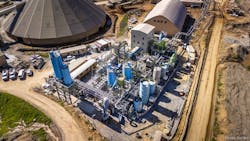Materials Innovator Fortera Gains $85M Investment to Accelerate Plant to Mineralize CO2 into Cement
Fortera, a materials technology company paving the way to zero CO2 cement, has received $85 million in Series C funding to increase deployment of its low-carbon cement technology integrating with existing infrastructure.
The operations are under process at Fortera’s ReCarb plant located on the CalPortland campus in Redding, California. Fortera takes the industrial carbon dioxide (CO2) from CalPortland’s kiln and uses the ReCarb technology to produce ReAct cement.
The company intends to proceed with additional plants to produce ReAct green cement, which has 70 percent less CO2 per ton as compared to ordinary cement, the company says.
In the U.S. alone, traditional cement production averages nearly one metric ton of CO2 per metric ton of cement or clinker produced, according to Environmental Protection Agency data. Developing nations are estimated to emit close to 1,000 metric tons of C02 annually, environmental studies suggest.
The Series C funding round included participation from previous Fortrea investors such as Khosia Centures and Temasek. New funding came from Wollemi Capital, NOVA by Saint-Gobain, Presidio Centures and Alumni Ventures.
No Silver Bullet to Net Zero: EnergyTech Exclusive with Saint-Gobain
As noted, Fortera’s ReCarb process is attached to the existing cement manufacturing plants, captures the industrial CO2 emissions from traditional cement production and converts it to mineral form to achieve a ready-to-use low-carbon cement. The company’s process integrates into established infrastructure, including feedstocks, capital investments, logistics, and sales networks, thus wide-scale commercialization is shorter and more cost-effective.
The ReCarb technology operates at a reduced kiln temperature and is compatible with renewable energy integration, which will help reduce emissions and enable zero CO2 cement production. Full-scale ReCarb plants are expected to mineralize 165,000 tons of industrial CO2 and produce about 375,000 tons of low-carbon cement annually.
“Fortera does what previous green cement technologies have failed to do—it works with cement companies to provide an accessible solution to a cleaner industry,” said Natalie Volpe, Director at Wollemi Capital. “The compatibility with today’s ecosystem makes us confident that Fortera’s process is the most effective technology to decarbonize cement and achieve meaningful climate impact more quickly.”
The company’s ReAct cement, a form of calcium carbonate created from mineralized industrial CO2, equals the strength and durability of ordinary cement. It also meets existing regulations and is ASTM-approved as a partial cement substitute.
ReAct can be used alone or mixed with ordinary cement, reducing the carbon footprint of construction projects while maintaining strength and enhancing workability, the company says.
About the Author
Rod Walton, EnergyTech Managing Editor
Managing Editor
For EnergyTech editorial inquiries, please contact Managing Editor Rod Walton at [email protected].
Rod Walton has spent 17 years covering the energy industry as a newspaper and trade journalist. He formerly was energy writer and business editor at the Tulsa World. Later, he spent six years covering the electricity power sector for Pennwell and Clarion Events. He joined Endeavor and EnergyTech in November 2021.
Walton earned his Bachelors degree in journalism from the University of Oklahoma. His career stops include the Moore American, Bartlesville Examiner-Enterprise, Wagoner Tribune and Tulsa World.
EnergyTech is focused on the mission critical and large-scale energy users and their sustainability and resiliency goals. These include the commercial and industrial sectors, as well as the military, universities, data centers and microgrids. The C&I sectors together account for close to 30 percent of greenhouse gas emissions in the U.S.
He was named Managing Editor for Microgrid Knowledge and EnergyTech starting July 1, 2023
Many large-scale energy users such as Fortune 500 companies, and mission-critical users such as military bases, universities, healthcare facilities, public safety and data centers, shifting their energy priorities to reach net-zero carbon goals within the coming decades. These include plans for renewable energy power purchase agreements, but also on-site resiliency projects such as microgrids, combined heat and power, rooftop solar, energy storage, digitalization and building efficiency upgrades.


